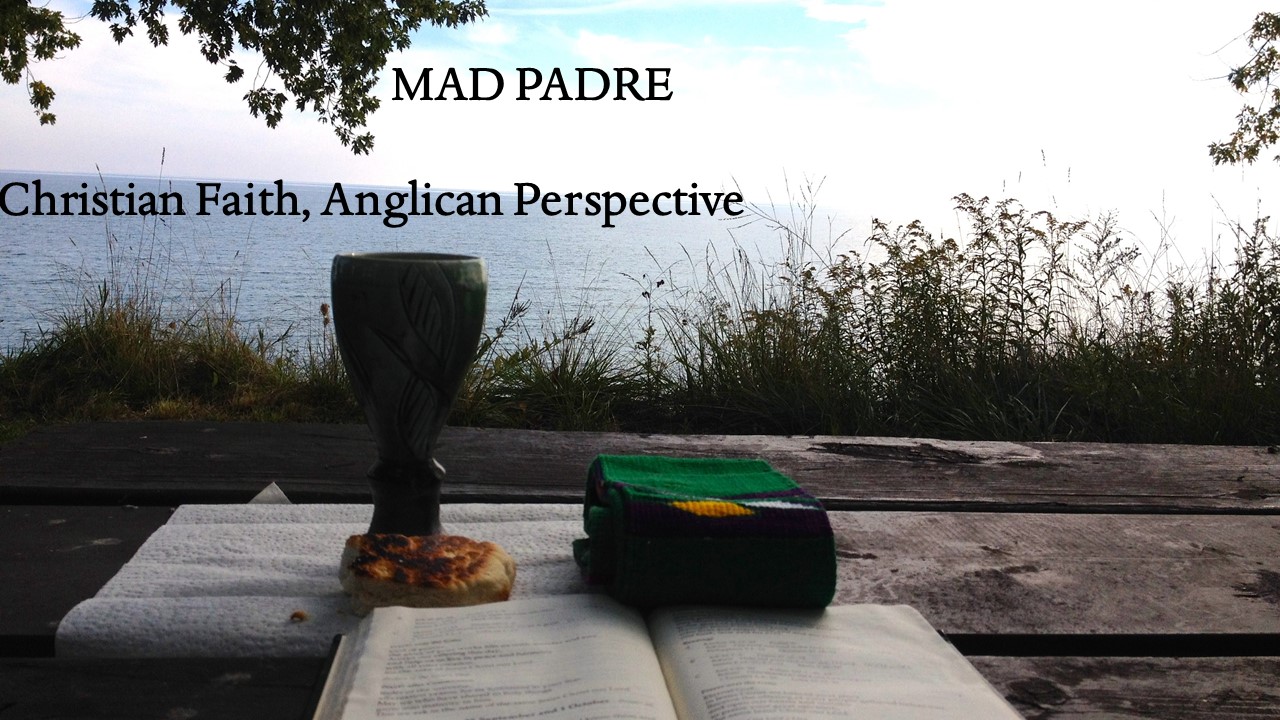Preached the Fifteenth Sunday after Pentecost, September 2, 2018, at St. Margaret’s Anglican Church, Diocese of Toronto, Barrie, ON,Mark 7:1-8, 14-15, 21-23; (First Reading) Deuteronomy 4:1-2, 6-9; (Semi-continuous First Reading) Song of Solomon 2:8-13; Psalm 15; (Second Reading) James 1:17-27 Song of Solomon 2:8-13
A READING FROM THE SONG OF SOLOMON
The voice of my beloved! Look, he comes, leaping upon the mountains, bounding over the hills. My beloved is like a gazelle or a young stag. Look, there he stands behind our wall, gazing in at the windows, looking through the lattice.
My beloved speaks and says to me: "Arise, my love, my fair one, and come away; for now the winter is past, the rain is over and gone.
The flowers appear on the earth; the time of singing has come, and the voice of the turtledove is heard in our land. The fig tree puts forth its figs, and the vines are in blossom; they give forth fragrance. Arise, my love, my fair one, and come away."
Today I’m going to do something I’ve never done before as a priest. I’m going to preach a sermon on the Song of Solomon, for several reasons. First, as you may have heard me say a few times, I love theHebrew Scriptures,, which I don’t think we hear preached on enough in the life of the church. Second, the Song of Solomon, also known as the Song of Songs or Canticles (I will just call it “the Song” in this sermon) is one of the strangest and loveliest books of scripture, a love poem which, because of its poetic and even sensual quality, sometimes seems out of place in the bible.
It seems a little random that we are hearing the Song as our first lesson this particular Sunday. Why is that? Well, all summer, as we followed one of the tracks of the schedule of readings known as the Lectionary, we have been hearing stories about King David. Two Sundays ago we heard about David’s death and started to hear about his son and heir, King Solomon. While he had his faults, scripture celebrates Solomon for his great wisdom, which it describes as the one blessing he asked of God and which God granted him (“I give you a wise and discerning mind; no one like you has been before you and no one like you shall arise after you” 1 Kgs 2:12).
Because of his reputation for wisdom, it was traditionally believed that Solomon was the author of the Book of Proverbs, which we will be hearing some of in September, and of Ecclesiastes. There was a traditional teaching of the ancient rabbis that Solomon wrote the Song as a young man in love, Proverbs as a mature man who has traded love for wisdom, and Ecclesiastes as an old man, somewhat jaded and well aware of his mortality. Biblical scholars tend to think that Solomon didn’t write all of these books, and that their actual authorship is much more complex. However the fact that the Song and Proverbs are attributed to Solomon is certainly one reason why they show up on in the liturgy of the church.
When you read it, you might well be surprised that the Song is even in the Bible, because it doesn’t seem very, well, biblical. The Song isn’t even a Song, really, but is best described as a kind of play in which there are two characters: the two lovers, the Man and the Woman, and then a group or chorus that comments on what is going on. It’s not a long book, just eight chapters, so it can read in one sitting, but depending which translation you are reading, it can be difficult to follow. The voices of the two lovers entwine, like a love duet, with expressions of desire and praise for the other’s beauty. The Song ends, much like our first reading today, with an expression of desire and a longing to be together:
"Make haste, my beloved,
and be like a gazelle
or a young star
upon the mountains of spices!” (SgS 8:14)
In the rest of this sermon, I would like to focus on three things. The first is how the Song reminds us of the importance of earthly, human love, something the church has not always been good at understanding. The second is how the Song describes love not just from the man’s point of view but also from the woman’s point of view, which again is something the church hasn’t been good at. Finally, I will talk about the importance of nature in the Song and how it connects our human world to the natural world as part of God’s creation.
The Song is, as I said, sensual in parts, even erotic, though the language is highly poetic in the language and images of the day. As the man and woman praise the beauty of each other’s bodies, there are some passages that wouldn’t make the greatest pickup lines today, as when the man says to the woman “Your belly is a heap of wheat, encircled with lilies” (Sg 7:2). That might not go over too well, like the man’s praise that “Your hair is like a flock of goats, moving down the slopes of Gilead” (4:1). On the other hand, verses such as “your kisses [are] like the best wine that goes down smoothly, gliding over lips and teeth”, well, those work just as well now as they did then. There are times where the Song just crackles with longing.
If you are wondering why the church saw fit to keep this book in the bible, that’s a good question. For a long time, well into the middle ages, the Song was read spiritually, so that it could be interpreted along the lines of the man being Christ and the woman being the church. However, the fact that someone would want to read the book this way, as opposed to just taking it literally as a love song, says something about the church’s long and tortured history with human sexuality, which goes right back to the story of how the nakedness of Adam and Eve in the garden was a sin, and which continued for centuries in celebrating chastity as godly and the human body as a source of temptation and evil. In such a worldview, marriage was a necessary evil, good only for the procreation of children.
The Song reminds us of the artificiality of this dualistic theology which celebrates spirit at the expense of body. It reminds us that real flesh and blood people lived in biblical times, just as they did today. It reminds us that human desire is natural, even beautiful, and that our bodies and our sexuality are gifts that are part of God’s creation. Our own Book of Alternative Services reminds us of this in the marriage liturgy, when it begins by describing marriage as “a gift of God” in which the partners may “know each other with delight and tenderness in acts of love” (BAS 528). The editors of the Serendipity Bible, designed for small groups in evangelical churches, uses the Song as the basis for a bible study on marriage and intimacy. The Song reminds us that our faith speaks to all areas of life, and that intimacy, trust, and affection can be part of our lives as Christians.
This realization is made more remarkable because the woman is a full and equal voice in the Song of Songs. If you heard the sermon that Jenn, our theological student, gave last month on the story of David and Bathsheeba, Jenn noted that Bathsheeba is essentially voiceless and powerless. She is merely a beautiful object that David wants and gets, however immorally he does so. In contrast, the woman in the Song is an equal partner in the duet. She speaks with as much poetry and passion, she relishes her lover’s beauty as much as he does hers, and her longing is just as strong as his:
Awake, O north wind,
and come, O south wind!
Blow upon my garden that its fragrance may be wafted abroad.
Let my beloved come to his garden and eat its choicest fruits.” (Sg 4:16)
The Song reminds us that men and women are equal and full participants in God’s creation.
The final thing I would point out about the Song is the importance of nature and natural images. In the passage from our first lesson, the woman describes her lover as being like “a gazelle or a young stag” (2:8) or elsewhere as an “apple tree”. Likewise the man describes the woman elsewhere as being a “dove”, a “mare”, and the woman describes herself as a “rose of Sharon” and a “lilly of the valleys”. The entire Song is full of references to animals, and one scholar has counted twenty four plant species. Biblical scholar Elaine James calls the Song a very green poem, written at a time when humans lived much more closely to the natural world than most people do today. The Song reminds us that the natural world, which appears to be changing and disappearing at a frightening rate, is part of God’s creation, and reminds us of our obligation as stewards of creation to care for that world.
So while the Song is in many ways a very sensual poem, full of natural images of the earth and of human desire, it is also a very spiritual poem. The idea of the earth coming back to life - for now the winter is past, the rain is over and gone - is also an image of redemption and salvation. One commentator I read this week noted that today’s passage would be a great scripture reading for a wedding where one or both parties had experienced a divorce or the loss of a spouse. Likewise, even for those of us for whom the youthful fires of love might have died down a bit, there is in the Song a powerful affirmation of human love as something that is powerful and wonderful.
Set me as a seal upon your heart, as a seal upon your arm
For love is strong as death, passion fierce as the grave.
Its flashes are flashes of fire, a raging flame. (Sg 8:6)
For those who carry the memory of a love and life well lived, or who nursed and cared for a loved partner through sickness and old age, the Song speaks to them as much as it speaks to young lovers. The Song of Songs is one of the great gifts of scripture, a reminder that God is with us even in the earthiness of our lives. The Song of Songs would make a great extended bible study, perhaps one day when I am brave enough to lead it, and some of you are brave enough to join me.
Amen.







